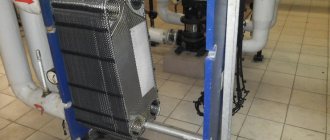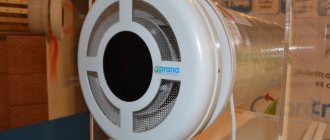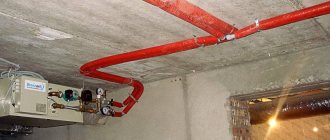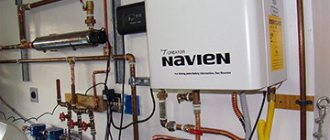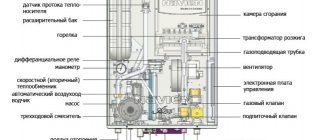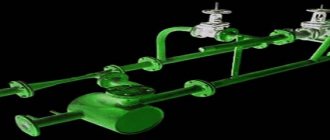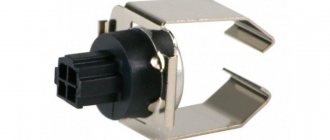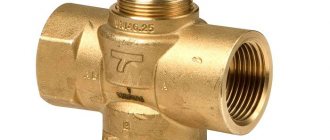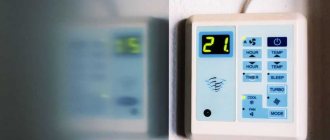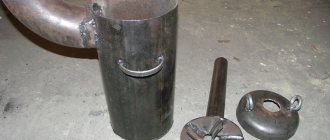A heat exchanger is a device that transfers heat from one heat source to another, while excluding direct contact of coolants. Therefore, theoretically, a heat exchanger can be installed in any heating system, the main thing is that it is beneficial, since the cost of the heating system itself increases in direct proportion to the load, or simply the cost of the installed heat exchanger itself with control measuring and control equipment.
The main area of application of heat exchangers in the heating system is an independent heat supply system . To understand why we need this, we need to take a short excursion into the nature of the heating networks we have in our country.
What is a heat exchanger?
The purpose of heat exchangers is to transfer heat from a heated medium to a cold one. And the application is not limited to any one area of industry - the equipment is used everywhere (in the energy sector, metallurgy, food and chemical industries, at heating points, in heating, ventilation and air conditioning systems, and so on).
Types of heat transfer equipment
1. Surface heat exchangers
Heat exchange between different media is carried out through walls made of a special heat-conducting material, i.e. the circuits here are completely sealed. Surface-type equipment, in turn, is divided into:
- recuperative (temperature exchange between coolants is carried out through the thin walls of the circuits, and the flow of the medium has a constant direction);
- regenerative (differ from recuperative ones in the changing direction of flow).
2. Mixing heat exchangers
Here, heat transfer is achieved by mixing two media and this type of heat exchanger is used much less frequently than the above.
Types of equipment by application
- shell-and-tube heat exchangers - consist of a bundle of pipes connected into a lattice by soldering or welding;
- plate heat exchangers - have a heat exchange area consisting of plates connected by heat-resistant seals;
- twisted heat exchangers - assembled from concentric coils, and the working medium in them moves through curved pipes and through the interpipe space;
- spiral heat exchangers - are thin steel sheets rolled into a spiral;
- water, air , etc.
There are a lot of species, so it simply doesn’t make sense to list them all. The most popular of the above equipment is considered to be a plate heat exchanger, so we will consider its features in more detail.
Selection and calculation of the cost of a heat exchanger in a convenient way for you
To get a consultation
We'll advise you on the task We'll tell you where to get the data We'll help you with the selection We'll tell you the price according to the labeling
Call you back?
Let's calculate according to parameters
We make calculations accurately and professionally, without any manipulation
Calculate
Do you have a ready-made heat exchanger calculation?
We will calculate the cost
according to the calculation number, serial number, calculation sheet, specification, according to the heat exchanger nameplate.
Get a price
. We will call you back within 1 minute.
results from 30 minutes
results in 5 minutes
Where can I get the calculation data for VET?
Calculated data (loads, pressures, temperature graphs) are issued by heat supply organizations (heating networks, boiler houses) in the form of explanatory notes, Technical Conditions (TU).
You can also take this data from a contract with a heat supply organization, or from a project for modernization or re-equipment of ITP, UUTO. If you still have questions about the calculation data, you can contact the manager for advice.
Heat exchange systems, why a heat exchanger is needed
An example of a mixing device is a cooling tower. The exhaust gases give off heat to the water sprayed from the nozzles. In devices where two agents flow through separate circuits, heat is transferred through the wall or surface.
A sign of a heat exchanger is a developed surface and the connection of two systems. It can be steam-water, antifreeze-water, water-water. Instead of water, a chemical solution is used in the process, and heated gases are used instead of steam.
The use of heat exchangers allows:
- Use residual heat to generate electrical energy.
- Carry out chemical processes in precise mode, maintaining the temperature with heat exchangers.
- Use secondary heat from energy carriers for domestic needs.
- Maintain the temperature of the coolant for domestic heating systems in parameters that comply with the standard.
More information about types of heat exchangers
1. Gasketed plate heat exchangers (consist of individual plates delimited by rubber gaskets, two end chambers, a frame and mounting bolts)
2. Brazed plate heat exchangers (consists of a set of metal corrugated plates made of stainless steel, which are connected to each other by vacuum soldering using copper or nickel solder)
3. Welded plate heat exchangers are designed for use in conditions of extremely high temperatures and pressures in installations whose parameters do not allow the use of seals. These heat exchangers are highly efficient, small in size and require minimal maintenance. Plate material – stainless steel, titanium, nickel alloys.
Working media – high-temperature steam, gases and liquids, including aggressive ones, as well as their mixtures. Welded TOs differ from RPTOs, again by the method of sealing the plates; in welded machines, the plates are welded with steel, and the formed welded cassettes are assembled inside steel plates. Used in those processes with aggressive media, gas media, at high pressures.
4. Semi-welded plate heat exchangers. Similarly, as in welded machines, the plates are welded into cassettes, but the method of connecting the cassettes to each other is through paronite joints. Scope of application – technical. processes with aggressive environments. The plate semi-welded heat exchanger is made in the form of a structure from a small number of welded modules. And they, in turn, are connected using laser welding in the form of a pair of plates. This entire structure is assembled between the end plates using bolts. A rubber seal is laid between each welded module.
Such heat exchangers are used in special cases when a substance with a very high temperature, pressure, any other dangerous parameter, or simply a dangerous substance will be used as a coolant. In this case, it will move in welded channels along the heat exchange plates.
5. Shell-and-tube heat exchangers (their main elements are tube bundles assembled into tube sheets and placed in a housing; pipes and pipe ends are attached to the tube sheets by flaring, welding, and soldering)
6. Spiral heat exchangers (the heating surface is formed by two thin metal sheets welded to the separator (core) and rolled in the form of a spiral) In a spiral heat exchanger, unlike RPHE, only two plates are used, rolled around the core into a spiral and “packed” in a welded casing .
Spiral devices are used in those. processes, with aggressive media and high pressures (PS, at the moment there is only one manufacturer left on our market - Alfa Laval. GEA and Sondex have refused to further produce these devices. Exceptional compactness and self-cleaning effect make Alfa Laval spiral heat exchangers highly versatile equipment – they are applicable both when working with liquid inhomogeneous media prone to the formation of deposits on heat transfer surfaces, and in the presence of condensation of steam or gas under high vacuum conditions.
What determines the efficiency of a heat exchanger?
Shell and tube t/o
Surface heat transfer always occurs through the wall. In this case, heat loss occurs. The thinner the partition, the less loss. The new shell-and-tube heat exchanger has an efficiency of 75%, but as the internal and upper surfaces become overgrown with sediment, the efficiency of the device decreases. It cannot maintain temperature. Therefore, the devices have a removable beam, which is cleaned under high pressure with a special gun.
Plate devices have an efficiency of 90%, but the gaps between the plates become clogged and require cleaning. The equipment is disassembled for cleaning. It is important to install a magnetic mesh filter in place, which prevents the formation of sediment. Plate heat exchangers can be connected to automated control.
Plate collapsible t/o
The efficiency of the process depends on the connection diagram. Heat transfer is more complete in a counterflow apparatus when the flows move towards each other.
The thinner the partition, the better the process. But for pressure vessels, the wall thickness depends on the ability to withstand the load on the walls. If it is impossible to thin the walls of the tubes, it is necessary to increase the heating surface and make the apparatus longer.
Each heating unit is manufactured in accordance with thermal engineering calculations, has a passport and is designed to work with a specific coolant.
Heat exchanger design
The equipment consists of two main plates - fixed and movable. Both plates have several holes for entry and exit of the medium. Between the two main plates there are many plates, which are sealed using rubber gaskets. Guides at the top and bottom determine the position of the equipment. The plates can be compressed to the desired size using special nuts. The arrangement of the plates is not accidental; one plate at a time is rotated 180° relative to its neighbors. Thanks to this, the inlet opening of the channel is sealed twice.
1 – front fixed plate, 2 – upper guide, 3 – rear movable plate, 4 – rear stand (tripod), 5 – working plate with seal, 6 – lower guide, 7 – pipes, 8 – rollers for moving the plates along the guides, 9 - nameplate with name and technical data, 10 - studs
Manufacturers of boilers with bithermic heat exchanger
Buyers have a choice when choosing a boiler with a combined heat exchanger. Many companies produce such units. For example:
- Baxi (Italy). Wall-mounted dual-circuit models Mainfour 24i and Mainfour 24Fi.
- Beretta (Italy). Wall-mounted models for heating and hot water supply Ciao Cai 28 kW, Ciao Cai 24 kW, Ciao Csi 28 kW, Ciao Csi 24 kW.
- Buderus (Germany). Wall-mounted models Logamax UO42-24K (single-circuit), double-circuit Logamax UO44-24K, Logamax UO52-24K, Logamax UO52-28K, Logamax UO54-24K.
- Roca (Spain). Wall-mounted models for hot water supply and heating Neobit S 24/24, Neobit S 24/24 F.
- Sime (Italy). Wall-mounted double-circuit models Metropolis DGT 25 BF, Metropolis DGT 25 ОF, Metropolis 25 ОF, Metropolis 30 ОF.
- Solly (China). Wall-mounted models for hot water supply and heating H Standart 18, H Standart 26, H Standart 18F, H Standart 26F.
- Termal (China). Wall-mounted dual-circuit models M 18 i, M 18Fi.
- Unical (Italy). Wall-mounted model for heating and hot water supply Eve 05 Ctn 24F.
Thus, boilers with a bithermic (combined) heat exchanger cost less and are more reliable due to their design features, however, they are less productive and require a certain quality of water for good operation.
Principle of operation
The main element of heat exchange is liquid. Liquids move in countercurrent through channels created by corrugated plates that form the channels. The wall corrugated layer, due to the high flow speed, begins to gain turbulence. Each medium moves along one plate, but from different sides, to avoid mixing. All heat exchanger plates are the same and installation is as easy as a welded heat exchanger. Thanks to this, the device forms a kind of package containing 4 collectors, they are designed for the input and output of various media. All plates take part in heat exchange with the exception of the outer ones (first and last).
Having even the lowest hydraulic resistance, heat transfer can be increased using fine flow and turbulence. At the same time, both turbulence and a thin flow clean the plates from unwanted and even the most persistent deposits.
The back and front plates have holes that connect to the pipeline and heat the media. Pipes may differ from each other in the method of connection (for example, there is a type with threads according to GOST No. 6357 and with threads according to GOST No. 12815). Both of them depend on the type of device. Heat exchanger plates placed parallel create channels. After passing through all channels, the medium exchanges heat and leaves the equipment. This means that the plates are the most important element of the entire heat exchanger. Their thickness is only 0.5 mm, they are made from stainless steel by cold stamping. Temperature-resistant rubber is installed between the plates, which makes the channels airtight. The incoming and outgoing holes are reinforced with a special gasket and rings, front and back, respectively.
The choice of heat exchanger takes into account its operating requirements. The higher they are, the more plates will be required. It is the number of plates that is responsible for overall efficiency.
Plate arrangement
The design and operating principle of a plate heat exchanger will depend on the modification of the equipment, which may contain a different number of plates with fixed gaskets. These gaskets block the channels with the passing coolant. To achieve the required tightness of the fit of pairs of interconnected gaskets, it is sufficient to fasten these plates with a movable plate.
The loads that act on this device are distributed, as a rule, onto the plates and seals. The frame and fastening elements, by and large, constitute the body of the equipment.
The relief surface of the plates during compression guarantees a strong fastening and allows the entire heat exchanger system to gain the necessary strength and rigidity.
The gaskets are fixed to the plates using a clip connection. It must be said that the gaskets are self-centered relative to their axis during clamping. Leakage of the thermal fluid is prevented thanks to the edging of the cuff, which additionally creates a barrier.
For the installation of a plate heat exchanger, several types of seals are manufactured: with hard and soft corrugation.
More information about heat exchange equipment:
In soft plates, the channels are at an angle of 30 degrees. This type of device is characterized by high thermal conductivity, but low resistance to coolant pressure.
In rigid elements, when making grooves, an angle of 60 degrees is made. These devices are not characterized by increased thermal conductivity; their main advantage is the ability to withstand significant coolant pressure.
To achieve the best thermal efficiency, you can combine plates. Moreover, it must be taken into account that for optimal operation of the device, it is necessary that it operate in turbulence mode - the coolant must move through the channels without any delays. By the way, a shell-and-tube heat exchanger, where the design has a “pipe-in-pipe” design, has a laminar coolant flow.
What is the advantage? While maintaining the same thermal characteristics, plate equipment has significantly smaller dimensions.
Areas of application
Food industry. When producing alcohol, beer, vegetable oil, sugar and dairy products, heat exchangers are necessarily used. Here they are intended for pasteurization of products, their cooling and possible evaporation. For such purposes, a soldered type of plate heat exchanger is very often used, although a gasketed heat exchanger is often also used.
Metallurgy. Cooling is needed in metallurgy more than anywhere else. This is due to the fact that ovens, beakers, various hydraulic systems and other devices generate enormous amounts of heat. To reduce this indicator, plate heat exchangers are used, which act as coolers. Brazed, welded and even spiral heat exchangers can be used as coolers. The choice of device directly depends on its operating conditions.
Shipbuilding. The heat exchanger is also responsible for cooling the ship's main engine and the entire central system. Here, instead of the usual medium, sea water or motor oils of various viscosity levels can be used. In addition, heat exchangers can be used on ships to maintain the operation of the heating system and for hot water supply, but this applies exclusively to large ships.
Oil and gas industry. Plate heat exchangers are also used for cracking, cooling and heating oil. Often such heat exchangers:
- low pressure
- network
- chemical water treatment
In such heat exchangers, it is customary to use titanium plates, 7 millimeters thick, with a pressure of 25 bar. For such equipment, NBR or Viton seals are used if gaskets resistant to high temperature conditions are needed.
Communal heating. Water heating, “warm floors”, hot water supply - plate heat exchangers are also used for all this. Such a device is capable of operating at temperatures up to 150 degrees Celsius, with pressures up to 16 kPa. Such heat exchangers use anti-corrosion steel plates, the thickness of which can reach 5 millimeters. There is an ethylene propylene seal.
Wall-mounted boilers with bithermic heat exchanger
Let's figure out what a bithermic heat exchanger is. From its name it is clear that we are talking about performing two different tasks inside one structure (this is heating water for heating and hot water supply).
For this purpose, a heat exchanger with a special pipe design is used. Most often, it is made of copper and has an internal contour whose cut shape resembles an irregular diamond, soldered to the inner surface of the main pipe.
This simple design allows you to use the internal area for hot water supply, and the external space for heating. Also, for better heat transfer, the outer pipe is equipped with plates that provide the greatest contact with combustion products.
Operating principle
- The plates heat up as a result of fuel combustion and transfer heat to the coolant circulating inside the heating circuit. If hot water is not used for domestic needs, then the DHW circuit is closed.
- When you open a hot water tap, the heating circuit is blocked and the DHW circuit opens, as a result of which the coolant moving through the inner tube is heated. As soon as the hot water tap is closed, the DHW circuit will automatically close and the movement of coolant in the heating circuit will resume.
In other words, only one of the two circuits is always working, while the DHW water receives heat from the already heated water from the heating circuit. It is believed that boilers with bithermic heat exchangers are 15% cheaper than using separate heat exchangers. But in this case, the efficiency is slightly less (by about 2%).
Advantages of boilers with bithermic heat exchangers
- A simple design that does not require the installation of a three-way valve, which quite often breaks and needs to be replaced.
- Such boilers have more compact dimensions, since no additional space is required inside the housing to accommodate a second heat exchanger.
- Hot water flows immediately from the tap when opened, unlike using boilers with separate heat exchangers.
- Due to their simpler configuration, many models are cheaper than boilers with an additional heat exchanger.
Some people mistakenly believe that the water from the DHW circuit, located in the inner tube of the heat exchanger, still takes a significant part of the heat when only heating is required, and reduces the overall efficiency of the boiler. Practice shows that this is not the case, and there is no cause for concern.
Flaws
- Possibility of getting burned while taking a shower. When using a boiler with a bithermal heat exchanger, you need to be more attentive to the temperature of the hot water, especially if there are children in the house. This problem is most pressing when there is severe frost outside and the heating is working at full capacity. After turning on the hot tap, it is better to wait a little while the very hot water drains.
- The duration of operation of the boiler in DHW mode has some limitations. This point needs to be clarified by specialists who are well acquainted with the boiler model you are purchasing with a bithermal heat exchanger.
- It is undesirable to use a coolant with a high content of impurities, as this will lead to the formation of scale on the inner walls of the heat exchanger tubes. If the water you use is too hard, it will need to be softened, which is an additional cost. In our practice, there are cases where the owners of such boilers did not monitor the quality of water in the heating system, and the heat exchanger failed during severe frosts. You understand what serious problems this causes.
- Difficult maintenance. Bithermic heat exchangers are difficult to clean, even if this procedure is entrusted to professionals.
- Due to clogging of the heat exchanger, the efficiency of the boiler decreases every year.
We recommend: Wall-mounted and other radiators, convectors for the bathroom
Sooner or later there comes a time when the bithermal heat exchanger will have to be replaced. Costs can reach 30-40% of the cost of the boiler. Agree that these are quite large expenses. However, payment for work is not taken into account here.
Without any exaggeration, we can say that bithermic heat exchangers are disposable, since their cleaning does not give much results due to their specific design.
We can only recommend using such boilers in combination with special cleaning systems that reduce the amount of salts in the coolant.
An example of a boiler with a bithermal heat exchanger is the wall-mounted boiler Baxi Eco Four 24. It has compact dimensions (400x730x299 mm), relatively light weight (29 kg) and is recommended for installation in houses with an area of up to 240 m2.
Initial data and calculation of the heat exchanger
1 — Temperature at the inlet and outlet of both circuits. Example: Maximum inlet temperature is 55°C and LMTD is 10°C. The heat exchanger will be cheaper and smaller in the case where this difference is greater.
2 — Maximum permissible operating temperature, medium pressure. The price will be lower if the parameters are poor.
3 — Mass flow (m) of the working medium in both circuits (kg/s, kg/h). Or the throughput of the heat exchanger. Often only one parameter is indicated - the volume of water consumption. The total mass flow can be calculated by multiplying the throughput volume by the density. For example, the density of cold water in the central system is approximately 0.99913.
4 — Thermal power (P, kW). Or the thermal load (the amount of heat given off by the heat exchanger) is calculated using the formula:
P = m * cp * δt
- where m is the flow rate of the medium
- cp – specific heat capacity (for water heated to 20 degrees, equal to 4.182 kJ/(kg * °C))
- δt – temperature difference at the input and output of one circuit (t1 - t2)
5 - Additional characteristics.
- to select the composition of the plates, it is necessary to find out in what working environment the heat exchanger will be used and its viscosity;
- average temperature difference LMTD (calculated by the formula ΔT1 - ΔT2/( In ΔT1/ ΔT2), where ΔT1 = T1 (hot circuit inlet temperature) - T4 (hot circuit output) and ΔT2 = T2 (cold circuit input) - T3 (output cold circuit);
- environmental pollution level (R) - rarely used, since this parameter is needed only in some cases.
Video “How to calculate a heat exchanger?”
Advantages and disadvantages
Advantages of single block radiators:
- low level of heat loss.
- Reliability of materials - there is only one connection that connects the block with the system channels.
- High efficiency of heat supply in two directions.
- The orientation of the control thermostats to a single unit provides 100% accuracy in obtaining data.
Disadvantages of bithermal radiators:
- Limited operation of the layers - liquids for supplying hot water supply and heating cannot be allowed to circulate at the same time.
- Coaxial circuits can quickly fail due to scale formation or corrosion of metal parts. Therefore, it is necessary to additionally use neutralizing inhibitors.
- Productivity is slightly reduced compared to boilers with separate blocks - for hot water supply and space heating.
Comparison table of shell and tube and plate equipment
| Characteristic | Shell and tube heat exchangers | Gasketed plate heat exchangers |
| Heat transfer coefficient (conditionally) | 1 | 3 — 5 |
| The difference (possible) between the temperatures of the coolant and the heated medium at the outlet | Not less than 5-10 °C | 1 - 2 °C |
| Change in heat exchange surface area | Impossible | Acceptable within a wide range, a multiple of the number of plates |
| Internal volume (conditionally) | 100 | 1 |
| Assembly connection | Welding, rolling | Detachable |
| Accessibility for internal inspection and cleaning | Non-separable, difficult to access, simple replacement of parts is impossible; only flushing possible | Collapsible. Easily accessible inspection, maintenance and replacement of any part, as well as mechanical washing of the plates. |
| Disassembly time | 90 - 120 min. | 15 minutes. |
| Tube (plate) material | Brass or copper | Stainless steel |
| Seals | Non-separable. Simple replacement is not possible | Glueless seals are easily replaced with new ones. The plates are rigidly fixed in the channels. No leaks after mechanical cleaning and assembly |
| Leak detection | Cannot be detected without disassembly | Immediately after occurrence, without disassembly |
| Susceptibility to corrosion at temperatures above 60 °C | Yes | No |
| Sensitivity to vibration | Sensitive | Insensitive |
| Assembled weight (conditionally) | 10 — 15 | 1 |
| Thermal insulation | Required | Not required |
| Operating life up to cap. repairs | 5 – 10 years | 15 – 20 years |
| Dimensions (conditionally) | 5-6 | 1 |
| Special foundation | Required | Not required |
| Cost (conditionally) | depending on the purpose and connection diagram 0.75 – 1.0 | 1,0 |
LEAVE A REQUEST and our specialist will help you select equipment
FILL OUT THE ONLINE APPLICATION FORM
Fields that you have difficulty filling out, simply leave them blank. Indicate the available values and contacts for communication.
We will select the best solution to suit your requirements
- Accurate technical calculation without errors.
- We do not reduce the cost by manipulating technical parameters.
- For the most complex tasks, we involve engineers from the manufacturing plant.
- We take into account the technical nuances and help you collect the necessary data for the calculation.
Connection diagrams
A heat exchanger operating on the water-to-water principle has several different connection schemes, however, the primary type circuits are mounted to the distribution pipes of the heating network (it can be private or implemented by city services), and the secondary type circuits are mounted to the water supply pipeline.
Most often, it depends only on design decisions what type of connection is allowed to be used. Also, the installation diagram and its choice are based on the standards of “Design of Heating Stations” and in the SP standard under number 41-101-95. If the ratio and difference of the maximum possible water heat flow for hot water supply to the heat flow for heating is determined in the range from ≤0.2 to ≥1, then the basis is a connection diagram in one stage, and if from 0.2≤ to ≤1, then from two degrees .
Standard
The simplest and most cost-effective scheme to implement is parallel. With this scheme, heat exchangers are mounted in series with respect to the control valve, that is, the shut-off valve, and also in parallel with the entire heating network. In order to achieve maximum heat exchange within the system, high heat carrier flow rates are required.
Two-stage scheme
Two-stage mixed system
If you use a two-stage scheme, then water is heated either in a pair of independent devices or in a monoblock installation. It is important to remember that the installation scheme and its complexity will depend on the overall network configuration. On the other hand, with a two-stage design, the efficiency level of the entire system increases and the consumption of coolants decreases (by about 40 percent).
With this scheme, water preparation occurs in two steps. The first step uses thermal energy to heat the water to 40 degrees, and the second step heats the water to 60 degrees.
Serial connection
Two-stage sequential circuit
This circuit is implemented within one of the devices for DHW heat exchange, and this type of heat exchanger is much more complex in design when compared with standard circuits. It will also cost much more.
Material of manufacture
The heat exchanger for the boiler is made from durable materials that conduct heat well, are not prone to corrosion and are sufficiently resistant to pressure. Since the cost of the material also has to be taken into account, the choice is limited.
Steel
A steel heat exchanger is cheaper in price, but less durable.
This is the most affordable material. Steel is very strong, but can be processed well. The price is low. The advantage of this option is resistance to high temperatures. Steel is plastic and does not crack when heated, and does not deform even in areas in contact with the burner.
A steel heat exchanger for a solid fuel or gas boiler is prone to corrosion. Water inside the tubes and combustion products in the boiler chamber have a destructive effect on the material. This affects durability. The steel model weighs a lot, which leads to additional fuel consumption for heating the element itself.
The stainless steel heat exchanger is resistant to corrosion and lasts for at least 50 years.
Cast iron
The material is much more resistant to corrosion than steel, and is not afraid of rust and the action of acid anhydrides. The service life reaches 50 years. However, cast iron is a brittle alloy and can crack under the influence of temperature. To avoid damage, the cast iron tubular heat exchanger must be washed: if ordinary water is used, then once a year; if antifreeze - then once every 2 years; if distilled liquid - once every 4 years.
The weight of a cast iron element is even greater, so more fuel and time have to be spent on heating.
Copper
Copper is a noble metal that is not susceptible to any type of corrosion. It is chemically inert and tolerates pressure well. Copper conducts heat better, so less fuel is required to heat the element itself and the flowing liquid. The weight of the copper model is small, the dimensions are compact with a very developed working surface.
The disadvantage is the high price. Also, the copper heat exchanger is too sensitive to heating to high temperatures. More often found in boilers from foreign manufacturers.
Copper
Cast iron
Advantages of ordering a plate heat exchanger from us:
- Accurate calculation of the heat exchanger. We select adapted equipment for your project.
- Objective price guarantee. By optimizing the power of equipment, we do not inflate the price.
- We process applications promptly.
- We organize the production, delivery and connection of plate heat exchangers on favorable terms.
- We offer wholesale prices through direct cooperation with leading manufacturers.
- We bear full responsibility for meeting deadlines and quality of equipment.
Call us, we will help you solve your problem, calculate and design the device, organize delivery and installation. We offer Russian-made plate heat exchangers with high efficiency and favorable technical parameters and characteristics. The catalog provides approximate descriptions of models, purposes and operating features of plate-type heat exchangers.
Contact us in any situation
The equipment has failed (emergency situation)
We will agree with the factory to reduce production time and organize express delivery.
The equipment is outdated, scheduled regular maintenance
We will take into account all the requirements: we will select a solution to suit the existing overall and connection dimensions.
Increase in capacity / reconstruction / modernization
We will help you collect all the necessary data for the calculation. We will select the necessary equipment and provide a solution in the form of an installation diagram.
Calculation of economic justification
We help with justifying the decision and price to management.
Verification of contractors
We will calculate the option for your budget and tell you which equipment is more profitable to purchase yourself.
